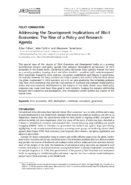Posted on 01 Mar 2017
Overview
This briefing paper examines the measurement of illicit arms flows in Niger in the context of the UN Sustainable Development Goals (SDGs), specifically SDG 16. Under Target 16.4, the 2030 Development Agenda considers the flows of illicit arms as an impediment to sustainable development and calls states to reach a significant reduction in such flows.
One of the challenges to assess weather ‘illicit arms’ have or have not been ‘significantly reduced’ is the very limited information available on the quantities, types, and value of illicit arms that circulate worldwide or in the region.
Understanding the sources of ‘illicit arms’ is the first step towards more effective interventions aimed at a reduction in illicit arms flows. The Paper finds that while over the past six years Niger has primarily served as a transit route for weapons circulating in the region, diversion from domestic stockpiles is a concern.
It notes that Nigerien security agencies all seize arms and describes the current state of data collection about those arms seizures. The paper goes on to note that while data is currently not comprehensive enough to assess progress done in implementing Target 16.4, the government is working to improve the situation. Data derived from other, non-government sources can be useful (such as UN embargo-monitoring groups, or peacekeeping missions and others) to complement the information provided by government sources.
Finally, it suggests that additional sources—including tracking arms and ammunition prices and data on the use of firearms in acts of violence—can serve as further possible indicators.
The Briefing Paper is also available in French – see below.




